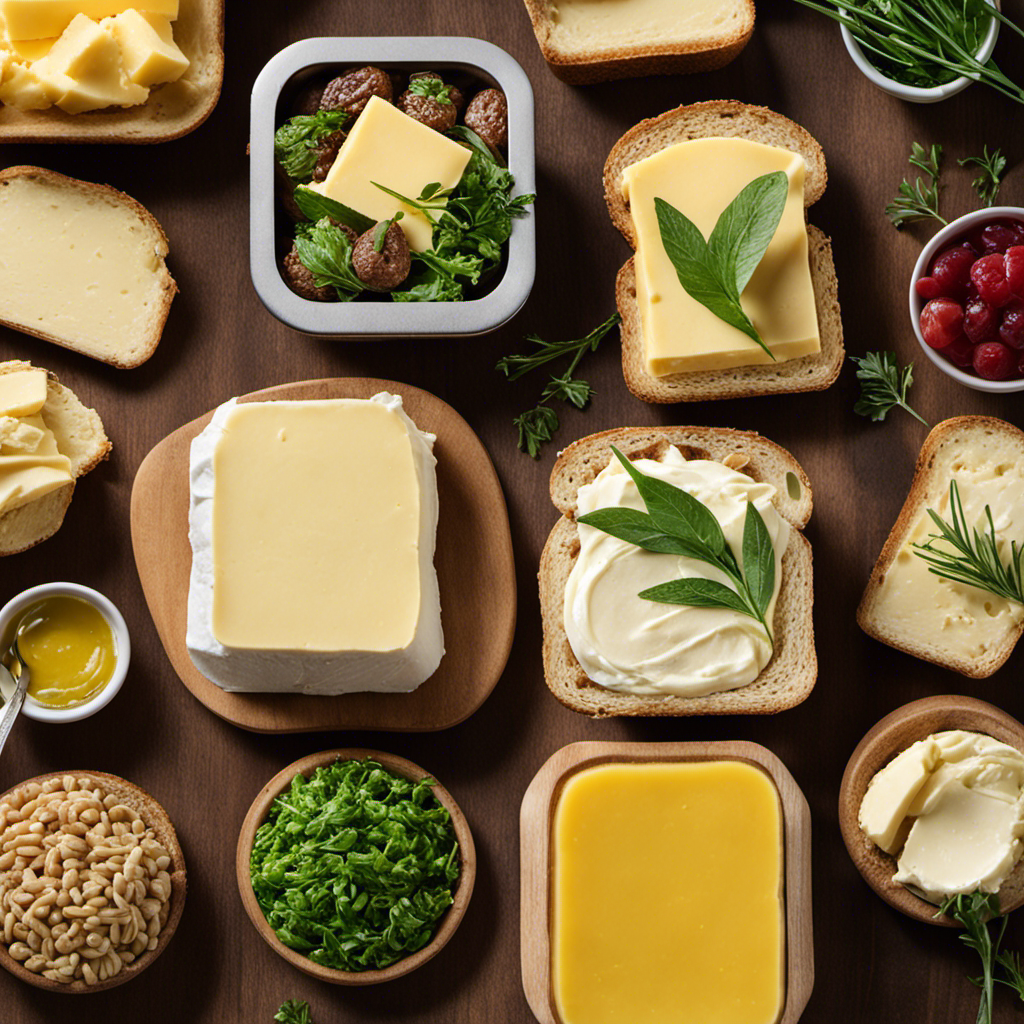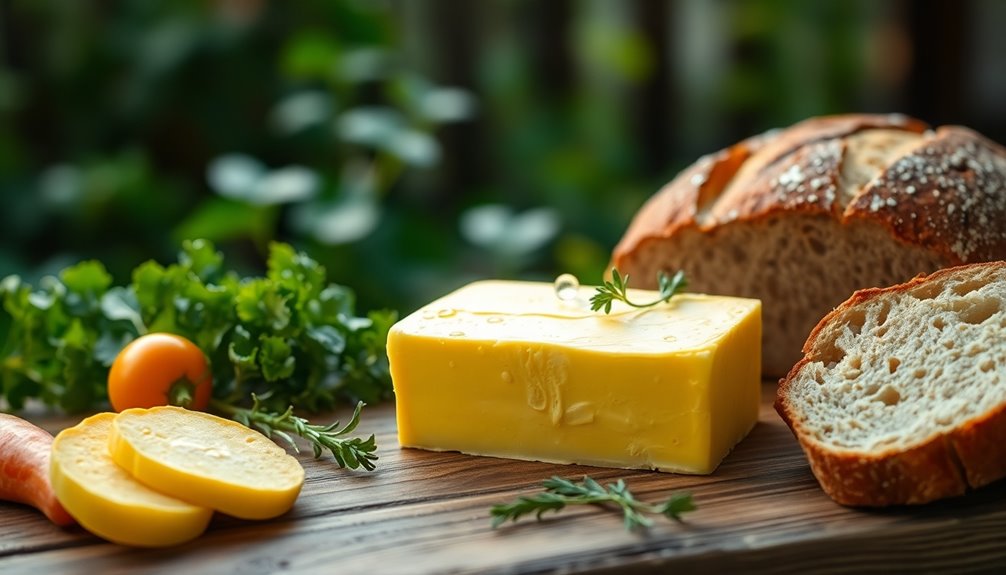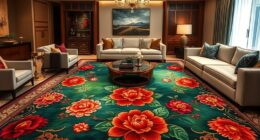As someone who deals with acid reflux, I have often wondered about which types of butter are safe to consume. Thankfully, I have done the research for you, and in this article, I will share what I have found.
We’ll explore different types of butter and their effects on acid reflux. From the benefits of clarified butter to the alternatives like ghee, we’ll cover it all.
We’ll also discuss the impact of grass-fed and organic butter, as well as the debate between salted and unsalted.
So, let’s butter up and dive into this informative journey.
Key Takeaways
- Clarified butter (ghee) is a good option for acid reflux as it is easier to digest, has a high smoke point for cooking, and has a rich and nutty flavor.
- Almond butter and peanut butter can be alternatives to regular butter for acid reflux, as they are lower in fat and can help alleviate symptoms.
- Butter alternatives like almond butter and peanut butter can also be beneficial for acid reflux, providing similar taste and texture without the high fat content.
- Grass-fed butter is believed to be healthier than conventional butter for acid reflux, as it contains higher levels of omega-3 fatty acids, CLA, and fat-soluble vitamins.
Different Types of Butter for Acid Reflux
There’s a variety of butter options that are good for acid reflux. When it comes to acid reflux, it’s important to choose a butter that is low in fat and doesn’t contain any added oils or flavorings.
One option is clarified butter, also known as ghee. Clarified butter has had the milk solids and water removed, leaving behind only the pure butterfat. This makes it easier to digest and less likely to trigger acid reflux symptoms.
Another alternative is almond butter or peanut butter. These spreads are made from ground nuts and are a healthier option compared to regular butter. They are lower in fat and provide a good source of protein.
It’s important to note that while butter alternatives may be better for acid reflux, moderation is key to avoid any potential health risks.
Health Benefits of Butter for Acid Reflux
The health benefits of butter can help alleviate symptoms of acid reflux. While butter may not be the best choice for individuals with acid reflux due to its high fat content, there are some potential benefits to consider.
- Butter contains butyrate, a type of fatty acid that has been shown to have anti-inflammatory properties. This can help reduce inflammation in the digestive tract, which may help ease symptoms of acid reflux.
- Butter is a good source of vitamins A, D, E, and K, which are necessary for overall health and can support the immune system.
- Butter is also rich in conjugated linoleic acid (CLA), a fatty acid that has been associated with various health benefits, including potential anti-inflammatory effects.
However, it’s important to note that butter can also exacerbate symptoms of acid reflux due to its high fat content. If you’re looking for alternatives, consider using olive oil, avocado, or nut butters, which are lower in fat but still offer some health benefits.
Now, let’s explore clarified butter: a safe choice for acid reflux.
Clarified Butter: A Safe Choice for Acid Reflux
Clarified butter is a suitable option for individuals with acid reflux. It is a type of butter that has had its milk solids and water content removed, leaving behind pure butterfat. This process makes it easier to digest and less likely to trigger acid reflux symptoms.
Cooking with clarified butter can be a great alternative for those who experience discomfort after consuming regular butter. It has a high smoke point, which means it can be heated to higher temperatures without burning or producing harmful compounds. This makes it ideal for sautéing, frying, or baking.
Additionally, clarified butter has a rich and nutty flavor that can enhance the taste of your dishes. Transitioning to ghee, another form of clarified butter, can further benefit individuals with acid reflux.
Ghee: An Alternative Butter for Acid Reflux
When it comes to finding relief from acid reflux, ghee may be a beneficial alternative to traditional butter.
Ghee, a clarified butter commonly used in Indian cuisine, has been touted for its potential health benefits.
Not only is ghee lactose-free and potentially easier to digest, but it also contains butyric acid, which research suggests may help reduce inflammation in the digestive system.
Health Benefits of Ghee
Ghee has several health benefits that make it a good option for individuals with acid reflux. Here are some of the benefits:
- Ghee is lactose-free, making it easier to digest for those with lactose intolerance or sensitivity.
- It contains butyric acid, a type of fatty acid that has been shown to have anti-inflammatory properties, which can help reduce inflammation in the digestive tract.
- Ghee is rich in fat-soluble vitamins like A, D, E, and K, which are important for overall health and can support digestion.
- Compared to butter, ghee has a higher smoke point, which means it can be heated to higher temperatures without producing harmful compounds.
- Ghee has a rich and unique flavor that can enhance the taste of dishes, making it a versatile and delicious option for cooking.
Acid Reflux Relief
If you’re experiencing heartburn, there are several natural remedies that can provide relief.
One natural remedy for acid reflux is ginger. Ginger has been used for centuries to soothe digestive issues, including heartburn. It works by reducing inflammation and promoting digestion.
Another natural remedy is chamomile tea. Chamomile has anti-inflammatory properties and can help relax the muscles in the esophagus, reducing the occurrence of acid reflux.
Additionally, apple cider vinegar is believed to help balance stomach acid levels and improve digestion.
It is important to note that while these remedies may provide relief, it is always recommended to consult with a healthcare professional for proper diagnosis and treatment of acid reflux symptoms.
Grass-Fed Butter and Acid Reflux
Grass-fed butter can be a good option for individuals with acid reflux. Unlike conventional butter, which comes from cows that may have been fed grain-based diets, grass-fed butter is made from cows that graze on grass. This difference in diet can affect the composition of the butter and potentially provide some benefits for those with acid reflux.
Here are a few reasons why grass-fed butter may be a better choice:
-
Higher levels of omega-3 fatty acids: Grass-fed butter tends to have higher levels of omega-3 fatty acids, which have anti-inflammatory properties that may help reduce symptoms of acid reflux.
-
More CLA: Grass-fed butter also contains higher levels of conjugated linoleic acid (CLA), which has been shown to have potential anti-inflammatory and antioxidant effects.
-
Rich in vitamins: Grass-fed butter is a good source of fat-soluble vitamins like A, D, E, and K, which are important for overall health and may help support digestion.
While grass-fed butter can be beneficial for acid reflux, let’s now explore the effects of organic butter on this condition.
Organic Butter and Its Effects on Acid Reflux
When it comes to butter, there is often a debate between grass-fed and conventional options.
Grass-fed butter is believed to be healthier due to its higher nutrient content, including omega-3 fatty acids and vitamin K2.
On the other hand, conventional butter is more widely available and typically more affordable.
Additionally, organic butter has been shown to have potential health benefits, such as a lower risk of heart disease and improved digestion.
Grass-Fed Vs Conventional
The taste of grass-fed butter is often preferred over conventional butter. When comparing grass-fed and conventional butter, there are notable differences in nutritional content and environmental impact:
-
Nutritional Differences:
-
Grass-fed butter contains higher levels of omega-3 fatty acids, which are beneficial for heart health.
-
Grass-fed butter has a higher concentration of vitamins A, E, and K2, which contribute to overall health and immune function.
-
Grass-fed butter has a better omega-6 to omega-3 fatty acid ratio, promoting a healthier balance in the body.
-
Environmental Impact:
-
Grass-fed butter is produced from cows that graze on pasture, which supports sustainable farming practices and reduces the need for intensive grain farming.
-
Conventional butter often comes from cows raised in confined feedlots, contributing to environmental issues such as water pollution and greenhouse gas emissions.
-
Grass-fed butter production promotes healthier soil, biodiversity, and carbon sequestration.
Considering these factors, grass-fed butter not only offers superior taste but also provides nutritional benefits and has a positive impact on the environment. Transitioning to the subsequent section about the health benefits of organic, it is important to explore how organic butter can further enhance our well-being.
Health Benefits of Organic
Organic butter, with its higher levels of vitamins and lower pesticide residue, can be a healthier option for those seeking to improve their overall well-being. When it comes to acid reflux, organic butter may also offer some benefits.
Acid reflux occurs when the stomach acid flows back into the esophagus, causing discomfort and a burning sensation. Studies have shown that consuming organic foods, including organic butter, can help reduce the risk of developing acid reflux. This is because organic butter is made from milk from cows that have not been treated with hormones or antibiotics, which can contribute to digestive issues.
Additionally, organic butter contains healthy fats that can help soothe the esophagus and reduce inflammation.
Transitioning to the next section, let’s explore how butter can affect digestion as a whole.
Butter and Digestion
When it comes to digestion and butter, there are a few things to consider. First, some people may experience discomfort or acid reflux after consuming regular butter due to its high fat content. However, there are butter alternatives available that can be easier on the digestive system.
Here are a few key points to keep in mind:
- Ghee: This clarified butter removes the milk solids and water, making it a suitable option for those with lactose intolerance or sensitive stomachs.
- Olive oil: Using olive oil instead of butter in cooking can provide a lighter option that is easier to digest.
- Avocado: Mashed avocado can be a great substitute for butter in baking recipes, adding a creamy texture without the potential digestive issues.
Salted Vs. Unsalted Butter for Acid Reflux
If you’re looking to alleviate acid reflux, you might want to consider opting for unsalted butter instead of the salted variety. While both salted and unsalted butter can trigger acid reflux symptoms due to their high fat content, the added salt in salted butter can exacerbate the condition.
Salt is known to relax the lower esophageal sphincter, allowing stomach acid to flow back up into the esophagus. On the other hand, unsalted butter contains the same amount of fat but lacks the added salt.
It is important to note that both dairy-based and plant-based butters can potentially worsen acid reflux symptoms. If you have acid reflux, it may be beneficial to explore alternative options such as olive oil or avocado as a substitute for butter.
Moderation and Portion Control With Butter for Acid Reflux
Using butter in moderation and controlling portion sizes can help manage symptoms of acid reflux. Here are some key points to keep in mind when it comes to portion control and acid reflux relief:
-
Opt for small amounts: Instead of slathering butter on toast or using it generously in recipes, try using a thin layer or a small pat.
-
Spread it out: Instead of consuming a large amount of butter in one sitting, spread it out throughout the day by using smaller servings.
-
Choose alternatives: Consider using alternatives to butter, such as olive oil or avocado, which are healthier options and may be better tolerated by those with acid reflux.
By practicing portion control and moderation with butter, you can still enjoy its flavor while minimizing the risk of triggering acid reflux symptoms.
Frequently Asked Questions
Can Butter Worsen Acid Reflux Symptoms?
Yes, consuming butter can worsen acid reflux symptoms. The type of butter may also affect the severity of symptoms. It is important to choose a type of butter that is low in fat and doesn’t contain additives or flavorings.
Are There Any Specific Brands of Butter Recommended for Acid Reflux?
I’ve discovered some recommended brands for acid reflux that can be beneficial. Additionally, using ghee instead of butter may provide some advantages. Let’s dive into the details and find out more.
Can Consuming Butter in Moderation Still Trigger Acid Reflux?
Yes, consuming butter in moderation can still trigger acid reflux. It is important to find healthy butter substitutes for individuals with acid reflux. Can butter alternatives help reduce acid reflux symptoms?
Should Individuals With Lactose Intolerance Avoid All Types of Butter for Acid Reflux?
Should individuals with lactose intolerance avoid all types of butter for acid reflux? While it’s true that butter can trigger symptoms, there are alternatives available like lactose-free butter or plant-based spreads that may be better tolerated.
Are There Any Specific Cooking Methods That Can Help Reduce the Risk of Acid Reflux When Using Butter?
When it comes to reducing the risk of acid reflux while using butter, there are specific cooking techniques that can help. Additionally, considering alternative spreads may be a good option.
Conclusion
In conclusion, when it comes to choosing the right butter for acid reflux, it’s important to consider various factors. These include the type of butter, its quality, and your own personal preferences.
Clarified butter, ghee, grass-fed butter, and organic butter are all good options to explore. However, it’s crucial to practice moderation and portion control to avoid exacerbating acid reflux symptoms.
Remember, finding the right balance is like finding a golden mean – it’s all about making informed choices for your well-being.










